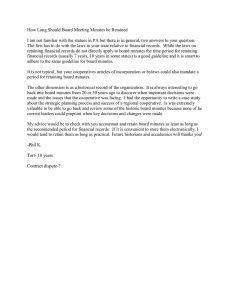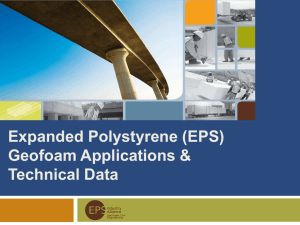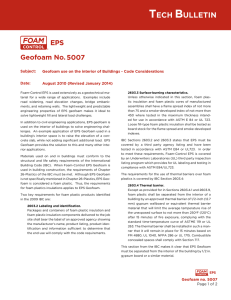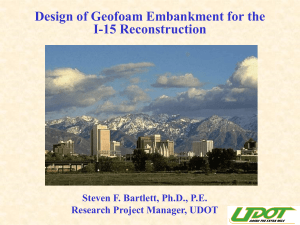IRJET-Study on Earth Pressure Reduction Techniques for High Raised Retaining Walls
advertisement
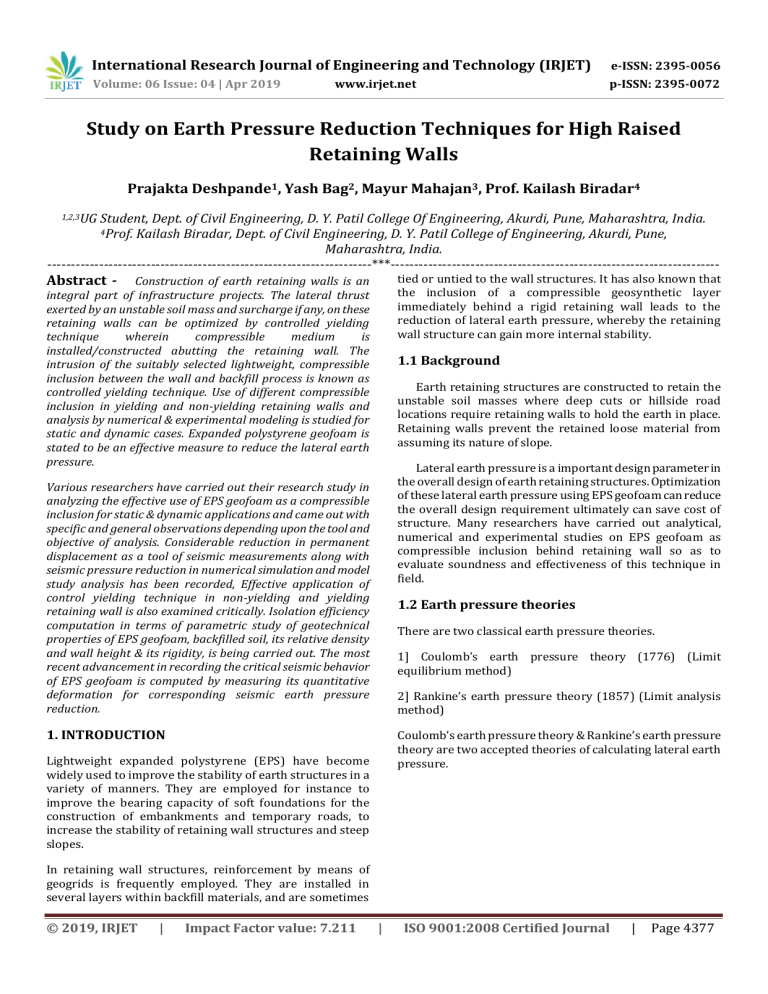
International Research Journal of Engineering and Technology (IRJET) e-ISSN: 2395-0056 Volume: 06 Issue: 04 | Apr 2019 p-ISSN: 2395-0072 www.irjet.net Study on Earth Pressure Reduction Techniques for High Raised Retaining Walls Prajakta Deshpande1, Yash Bag2, Mayur Mahajan3, Prof. Kailash Biradar4 1,2,3UG Student, Dept. of Civil Engineering, D. Y. Patil College Of Engineering, Akurdi, Pune, Maharashtra, India. 4Prof. Kailash Biradar, Dept. of Civil Engineering, D. Y. Patil College of Engineering, Akurdi, Pune, Maharashtra, India. ---------------------------------------------------------------------***---------------------------------------------------------------------- Abstract - tied or untied to the wall structures. It has also known that the inclusion of a compressible geosynthetic layer immediately behind a rigid retaining wall leads to the reduction of lateral earth pressure, whereby the retaining wall structure can gain more internal stability. Construction of earth retaining walls is an integral part of infrastructure projects. The lateral thrust exerted by an unstable soil mass and surcharge if any, on these retaining walls can be optimized by controlled yielding technique wherein compressible medium is installed/constructed abutting the retaining wall. The intrusion of the suitably selected lightweight, compressible inclusion between the wall and backfill process is known as controlled yielding technique. Use of different compressible inclusion in yielding and non-yielding retaining walls and analysis by numerical & experimental modeling is studied for static and dynamic cases. Expanded polystyrene geofoam is stated to be an effective measure to reduce the lateral earth pressure. 1.1 Background Earth retaining structures are constructed to retain the unstable soil masses where deep cuts or hillside road locations require retaining walls to hold the earth in place. Retaining walls prevent the retained loose material from assuming its nature of slope. Lateral earth pressure is a important design parameter in the overall design of earth retaining structures. Optimization of these lateral earth pressure using EPS geofoam can reduce the overall design requirement ultimately can save cost of structure. Many researchers have carried out analytical, numerical and experimental studies on EPS geofoam as compressible inclusion behind retaining wall so as to evaluate soundness and effectiveness of this technique in field. Various researchers have carried out their research study in analyzing the effective use of EPS geofoam as a compressible inclusion for static & dynamic applications and came out with specific and general observations depending upon the tool and objective of analysis. Considerable reduction in permanent displacement as a tool of seismic measurements along with seismic pressure reduction in numerical simulation and model study analysis has been recorded, Effective application of control yielding technique in non-yielding and yielding retaining wall is also examined critically. Isolation efficiency computation in terms of parametric study of geotechnical properties of EPS geofoam, backfilled soil, its relative density and wall height & its rigidity, is being carried out. The most recent advancement in recording the critical seismic behavior of EPS geofoam is computed by measuring its quantitative deformation for corresponding seismic earth pressure reduction. 1.2 Earth pressure theories There are two classical earth pressure theories. 1] Coulomb’s earth pressure theory (1776) (Limit equilibrium method) 2] Rankine’s earth pressure theory (1857) (Limit analysis method) 1. INTRODUCTION Coulomb’s earth pressure theory & Rankine’s earth pressure theory are two accepted theories of calculating lateral earth pressure. Lightweight expanded polystyrene (EPS) have become widely used to improve the stability of earth structures in a variety of manners. They are employed for instance to improve the bearing capacity of soft foundations for the construction of embankments and temporary roads, to increase the stability of retaining wall structures and steep slopes. In retaining wall structures, reinforcement by means of geogrids is frequently employed. They are installed in several layers within backfill materials, and are sometimes © 2019, IRJET | Impact Factor value: 7.211 | ISO 9001:2008 Certified Journal | Page 4377 International Research Journal of Engineering and Technology (IRJET) e-ISSN: 2395-0056 Volume: 06 Issue: 04 | Apr 2019 p-ISSN: 2395-0072 www.irjet.net 3. EXPANDED POLYSTYRENE GEOFOAM (EPS GEOFOAM) AS A COMPRESSIBLE INCLUSION: Geofoam is a cellular in structure and light weight material. Geofoam is any manufactured material created by some internal expansion process that results in a material with a texture of numerous, closed, gas-filled cells. For the expansion process requires gas; it is referred as blowing agent. Cellular materials are efficient in loading bearing because of their ability to support relatively large loads with relatively small amounts of material whether it is closed or open cell. EPS geofoam widespread in using worldwide compared to other geofoam even if similar engineering properties reasons are as: 2. CONTROL YIELDING TECHNIQUE The process of installation of a vertical layer of compressible medium abutting the retaining wall between the wall and backfill during the backfill so as to enable the soil to undergo lateral expansion to bring down the lateral pressure to active pressure level is known as the controlled yielding technique. It is the least expensive by a significant margin. It is using ecofriendly manufacturing. It is light weight material. It is inert in long term burial conditions. Weather resistant. High strength to density ratio. blowing agent for Application of EPS geofoam are widely spread in civil engineering construction are mentioned here: Reduced Earth pressure Concept Application of controlled yielding technique based on classification: Lightweight fill Thermal insulation Compressible inclusion Small-amplitude wave damping Drainage Retaining structures are broadly classified into two categories 1] Yielding: earth retaining structure, which undergo displacement, deformation or are allowed to displace or deform oe both in horizontal direction under design loads are generally grouped under yielding category. 2] Non-yielding: non-yielding is the type of field requirement of proposed earth retaining structure that is inherently incapable of both horizontal displacement and deformations. © 2019, IRJET | Impact Factor value: 7.211 | ISO 9001:2008 Certified Journal | Page 4378 International Research Journal of Engineering and Technology (IRJET) e-ISSN: 2395-0056 Volume: 06 Issue: 04 | Apr 2019 p-ISSN: 2395-0072 www.irjet.net inclusion. However, in case of yielding wall contrast to non-yielding wall, up to certain limiting value of thickness, a reduction in lateral thrust with the increase I thickness occur, thereafter no further decrease in lateral thrust. 6. REFERENCES 4. USE OF EXPANDED POLYSTRENE BLOCKS AND GEOGRIDS: The inclusion of a compressible layer such as expanded polystyrene blocks behind a rigid wall is capable of reducing the earth pressure at rest, in comparison to an unreinforced model specimen. This can be explained by a controlled yielding concept. However, the expanded polystyrene blocks inclusion scarcely alters the active earth pressure unless the length of the expanded polystyrene blocks in large enough. The combined use of expanded polystyrene blocks and geogrids layers is capable of reducing the earth pressure at rest, as well as the active earth pressure. The reduction in the earth pressure at rest can be demonstrated by a controlled yielding concept due to compression of expanded polystyrene blocks. The reduction in the active earth pressure can be related to tensile strains induced along the geogrid layers and also to the fixity between the expanded polystyrene blocks and the geogrid layers. [1] Athansopoulos, G. A., Pelekis, P. C. and Xenaki, V. C.(1999) “Dynamic properties of EPS geofoam: An experimental investigation”. Geosynthetics International, 6(3), 171-194. [2] Horvath, J. S. (1997) “The compressible inclusion functions of EPS geofoam.” Int. J. of Geotextiles and Geomembrane, 15,77-120. [3] Purnanandan, K. and Rajagopal, k., (2008) “Lateral Earth Reduction Due to Controlled Yielding Technique’’ Indian Geotechnical journal, 3893), PP 317 – 333. [4] Trandafir, A. C., and Ertugrul, O.L.(2011) Earthquake Response of a Gravity Retaining Wall with Geofoam Inclusion, Geo-Frontiers 2011, ASCE, 3177-3185. [5] Horvath, J. S. (1998a) “The compressible inclusion functions of EPS geofoam; An overview of concepts, Applications and products”, Res. Rpt. No. CE/GE-98-1, Manhattan Coll. Civ. Engg. Dept., Bronx, NY 7. BIOGRAPHIES 1 UG Student, Dept. of Civil Engineering, D. Y. Patil College Of Engineering, Akurdi, Pune, Maharashtra, India. 2 UG Student, Dept. of Civil Engineering, D. Y. Patil College of Engineering, Akurdi, Pune, Maharashtra, India. Zero Earth Pressure wall Concept 5. CONCLUSIONS 3 UG Student, Dept. of Civil Engineering, D. Y. Patil College of Engineering, Akurdi, Pune, Maharashtra, India. EPS geofoam being thermoplastic material time dependent behavior would be expected to be a design consideration. In case of non-yielding retaining wall there is reduction in the lateral thrust with increase in the thickness of EPS geofoam as a compressible © 2019, IRJET | Impact Factor value: 7.211 | ISO 9001:2008 Certified Journal | Page 4379 International Research Journal of Engineering and Technology (IRJET) e-ISSN: 2395-0056 Volume: 06 Issue: 04 | Apr 2019 p-ISSN: 2395-0072 www.irjet.net 4 Prof. Kailash Biradar, Dept. of Civil Engineering, D. Y. Patil College of Engineering, Akurdi, Pune, Maharashtra, India. © 2019, IRJET | Impact Factor value: 7.211 | ISO 9001:2008 Certified Journal | Page 4380
